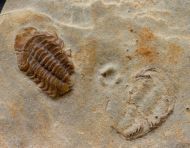Fossils for sale
Welcome back!
Here you find Trilobites from other localities.
Trilobites Worldwide
Trilobites are one of the most successful animal groups of the Paleozoic era worldwide. The earliest trilobites appear in the lower Cambrian about 521 million years ago and are found in almost all Paleozoic sediments worldwide.
During their successful evolutionary history, they survived four mass extinction events. Ultimately, they only succumbed to the mass extinction at the Permian-Triassic boundary about 252 million years ago. In the nearly 270 million years, trilobites had conquered almost every marine ecosystem. There are even indications that trilobites partially colonized brackish water areas. Within the nine orders of the class Trilobita, more than 150 families with a total of over 5000 genera have been described so far. More than 15000 species of trilobites have been scientifically described. And new species are still being discovered. Here is a small overview of the trilobite orders:
It should be noted that the order Nektaspida is only tentatively assigned to the actual trilobites. After all, the describer of the class Trilobita, Johann Ernst Immanuel Walch, had already pointed out the remarkable armor of the trilobites in 1771.Please note also this table uses a strong generalization. There will a lot exceptions to the short description for each Trilobite Order. In summary, it can be said that trilobites occur worldwide throughout the entire Paleozoic era and are also widely distributed as fossils today. There are only a few countries where no fossils of trilobites have been found.
| Order | Typical families | Short description | Typical representative |
|---|---|---|---|
| Agnostida Salter, 1864 | Agnostidae, Peronopsidae, Eodiscidae | Very small and smallest trilobites, usually only a few millimeters long. Age: Lower Cambrian to Upper Ordovician. | Itagnostus interstricta (WHITE, 1874) |
| Redlichiida Richter, 1932 | Redlichiidae, Olenellidae, Paradoxididae | Very old trilobites with many thoracic segments ending in pleural spines. Age: Lower Cambrian to Middle Cambrian. | Paradoxides gracilis (BOECK, 1827 |
| Corynexochida Kobayashi, 1935 | Corynexochidae, Ellipsocephalidae, Dorypygidae | Trilobites with a large glabella and a mostly smooth thorax. Age: Lower Cambrian to Upper Ordovician. | Ellipsocephalus hoffi (Schlotheim, 1823) |
| Lichida MOORE, 1959 | Lichidae, Odontopleuridae, Acanthopygidae | Trilobites with a large glabella and a mostly smooth thorax. Age: Lower Cambrian to Upper Ordovician. | Arctinurus boltoni(BIGSBY, 1825 |
| Phacopida SALTER, 1864 | Phacopidae, Cheiruridae, Calymenidae | Trilobites with large eyes and a mostly smooth or grooved thorax. Age: Middle Ordovician to Upper Devonian. | Phacops araw CHATTERTON et al., 2009 |
| Proetida Fortey & Owens, 1975 | Proetidae, Phillipsiidae, Bathyuridae | Trilobites with a small glabella and a mostly smooth or grooved thorax. Age: Lower Ordovician to Upper Permian. | Gerastos cuvieri (STEININGER, 1831) |
| Asaphida Salter, 1864 (emend. Fortey & Chatterton, 1988) | Asaphidae, Trinucleidae, Raphiophoridae | Trilobiten mit einem großen Glabella und einem meist glatten oder gerillten Thorax. Zeitalter: Unteres Ordovizium bis Oberes Silur. | Nobiliasaphus delessei (DUFET 1875) |
| Harpetida SALTER, 1864 | Harpetidae, Entomaspididae, Dikelocephalidae | Trilobites with a large glabella and a mostly smooth or grooved thorax. Age: Lower Ordovician to Upper Silurian. | Harpes macrocephalus (GOLDFUSS 1839) |
| Ptychopariida Swinnerton, 1915 | Ptychopariidae, Solenopleuridae, Olenidae | Trilobites with a medium-sized glabella and a mostly smooth or grooved thorax. Age: Lower Cambrian to Upper Ordovician. | Elrathia kingi (Meek,1870) |
| Nektaspida Størmer, 1943 | Naraoiidae, Emucarididae, Liwiidae | Trilobites without eyes and without calcification of the exoskeleton. Age: Lower Cambrian to Upper Silurian. | Naraoia spinosa Zhang & Hou, 1985 |
It should be noted that the order Nektaspida is only tentatively assigned to the actual trilobites. After all, the describer of the class Trilobita, Johann Ernst Immanuel Walch, had already pointed out the remarkable armor of the trilobites in 1771.Please note also this table uses a strong generalization. There will a lot exceptions to the short description for each Trilobite Order. In summary, it can be said that trilobites occur worldwide throughout the entire Paleozoic era and are also widely distributed as fossils today. There are only a few countries where no fossils of trilobites have been found.
